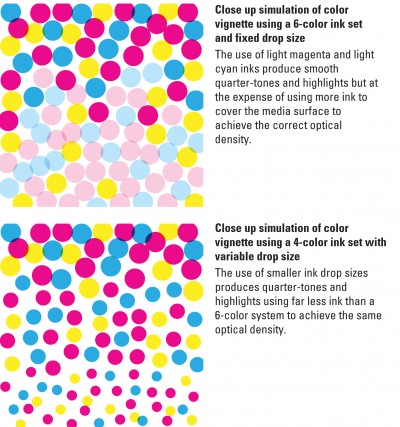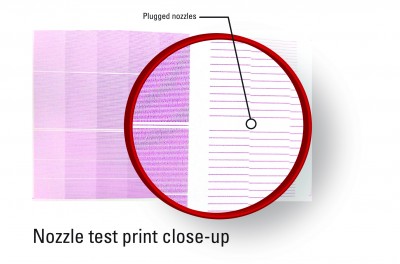Inks
Ink costs should not be measured simply by the price per litre. The quantity of ink used per print must also be calculated. Together, these figures can provide accurate projected costs per square metre of graphics.
There is a common misconception that UV-curable inks are more expensive than solvent-based inks. While they do cost more on a volume basis, they provide a significantly greater yield per litre.
This is because solvent-based inks mostly comprise the solvent itself, with relatively little pigment. The solvent, which is volatile, evaporates during drying, leaving the pigment on the media.
UV-curable inks do not evaporate. Instead, they cure during their exposure to intense UV light. As a consequence, much less ink is jetted per square metre of the media, compared to solvent-based inks.
There is a hidden cost when ink is wasted during routine maintenance of the printhead nozzles. To clear any blockages of these nozzles, a ‘purging’ process forces ink through them. Some printers purge all ink colours, regardless of which ones need it, and some purge automatically, without any operator instruction, which can quickly add up to significant ink costs. It is more ideal when the printer allows its operator to choose which colours of ink to purge and when.
The need for in-line white ink is generally limited to specialty applications, given most substrates are already white when purchased. Such specialty applications may include fabrics, packaging and building materials, as well as clear substrates for window graphics, backlit signage and mirror decals. Another option for backlit graphics, which may prove less expensive, is to apply a white adhesive vinyl diffuser or floodcoat manually.
RIPs
The raster image processor (RIP) is another essential component in a flatbed workflow. Basically, it translates the code behind a digital graphic into a language the printer will understand, converting each pixel or vector co-ordinate into an ink droplet.
The RIP can also process colour information from the file, which enables colour management throughout the process, using International Color Consortium (ICC) profiles to match colours all the way from a digital camera to image editing software to printed graphic. Some RIPs integrate Pantone’s library for spot colour matching, including support for white ink.
When accepting and directing jobs to the printer, a RIP allows users to intercept and edit images before printing, as well as archiving files for future use. RIPs can also support finishing, including the digital cutting of flexible or rigid substrates.
Some printer manufacturers specify one RIP to work with their machine. A generic RIP, on the other hand, may support all of the printers within the production department.
Curing technologies
UV-curable inks are turned from liquid to solid by high-intensity UV light. Specifically, chemical photo-initiators within the ink react to the light, setting off a polymerization of the ink, all in less than a second.
Most printers use mercury vapour lamps as their UV light sources, which offer a broad spectral range, with multiple peaks of energy. The inks are formulated to react to these peaks, which together are sufficient to initiate curing.
Another new, promising technology used in some flatbed printers is the UV light-emitting diode (UV-LED). It produces light with less heat as a byproduct, so it is more suitable for curing inks on heat-sensitive media.
UV-LEDs offer a much narrower spectrum than mercury vapour lamps, with fewer peaks of energy. So, inks must be carefully formulated to react efficiently. This can result in ink sets with a much smaller colour gamut.
Also, the lower power and more specific wavelengths of UV-LED systems can result in less complete ink curing in the printing zone, so some manufacturers have added secondary, off-line curing systems to their printers.






